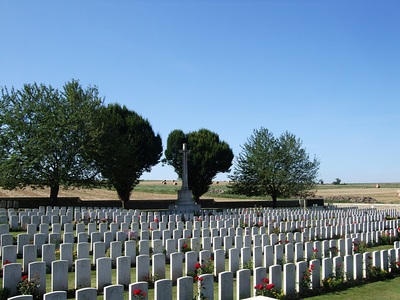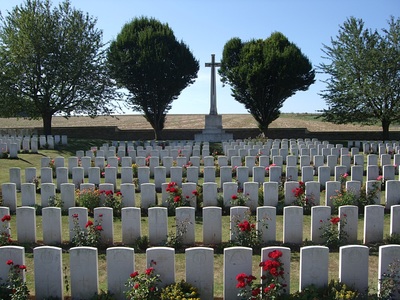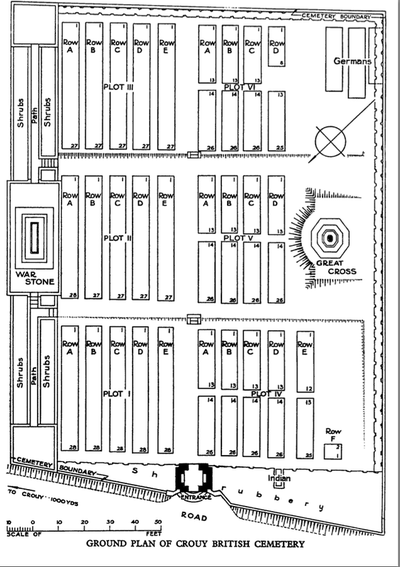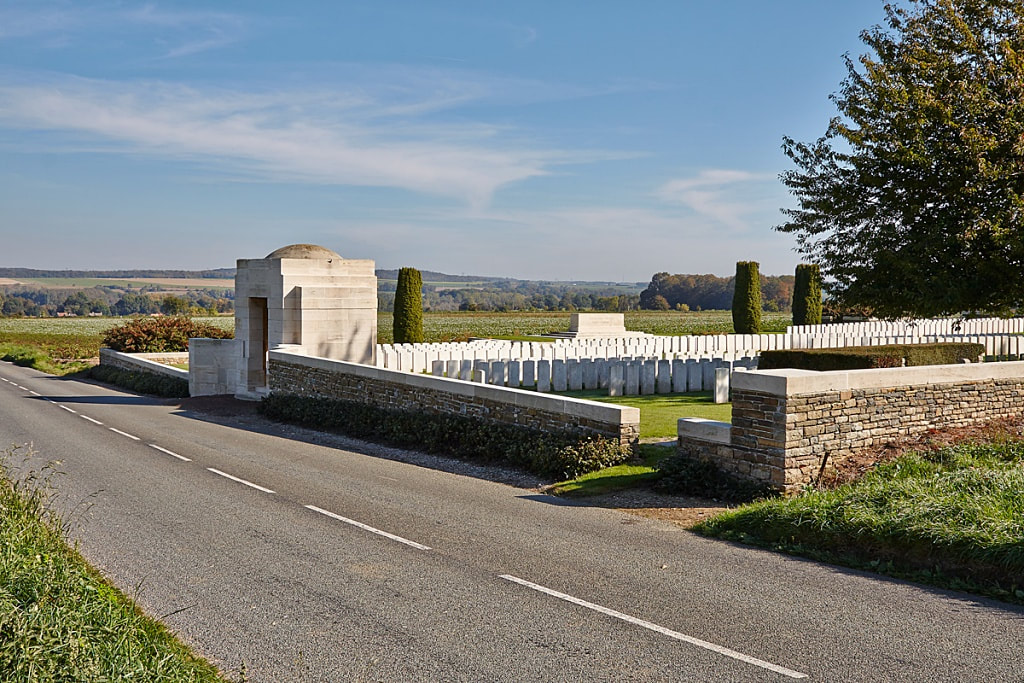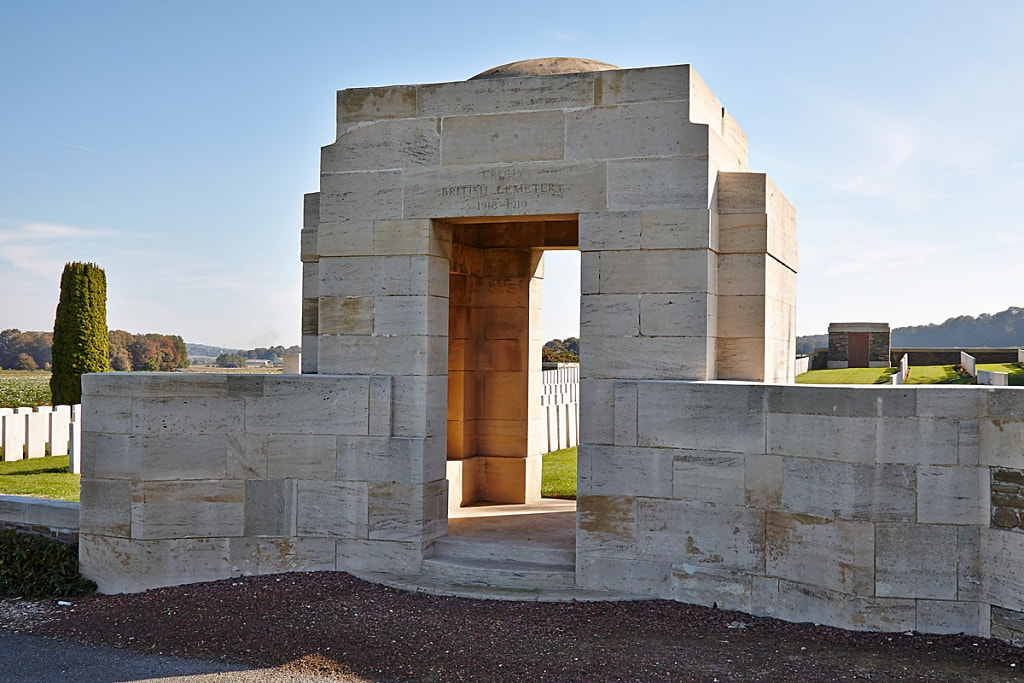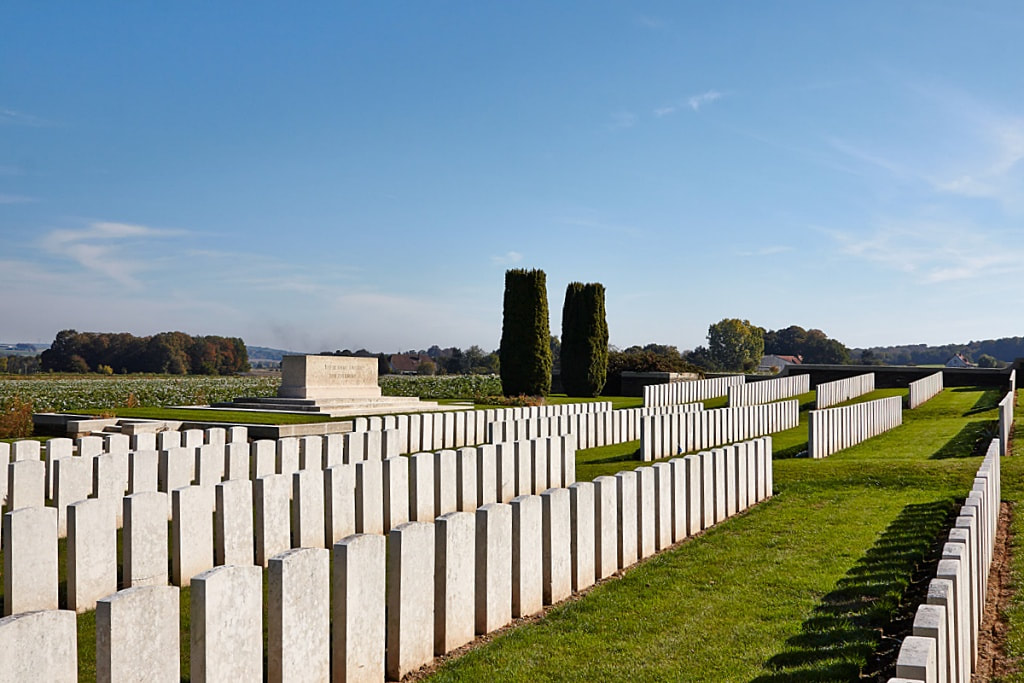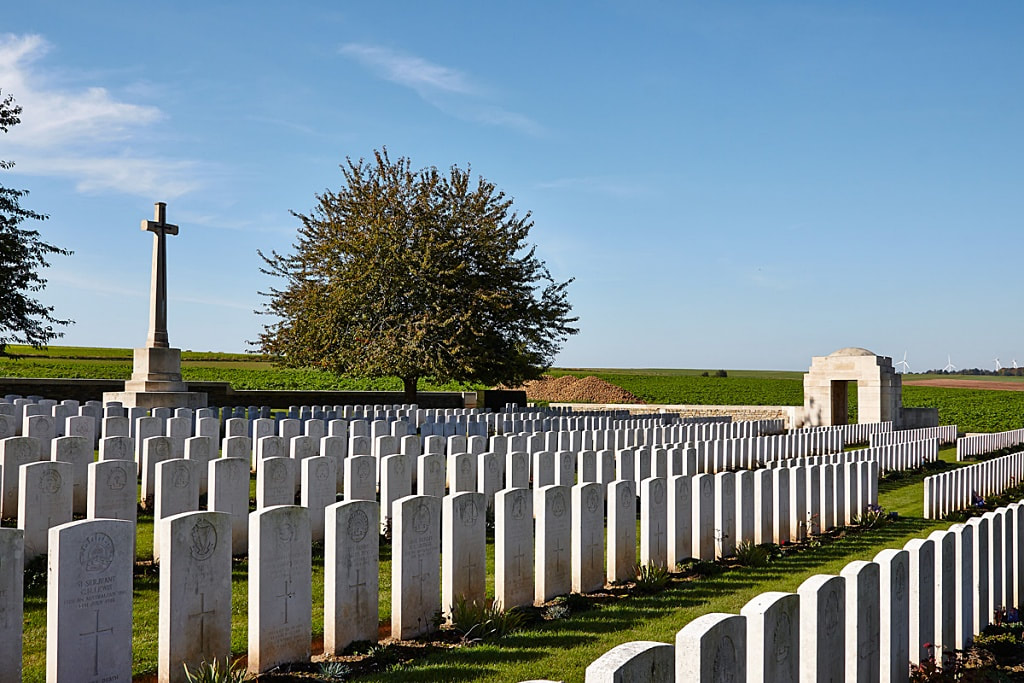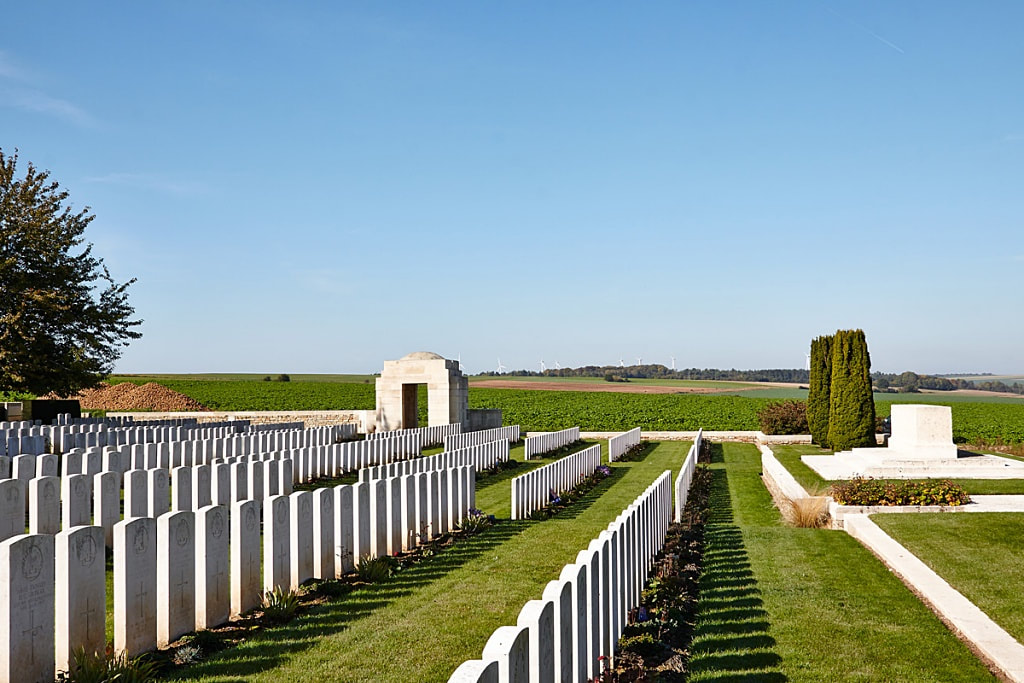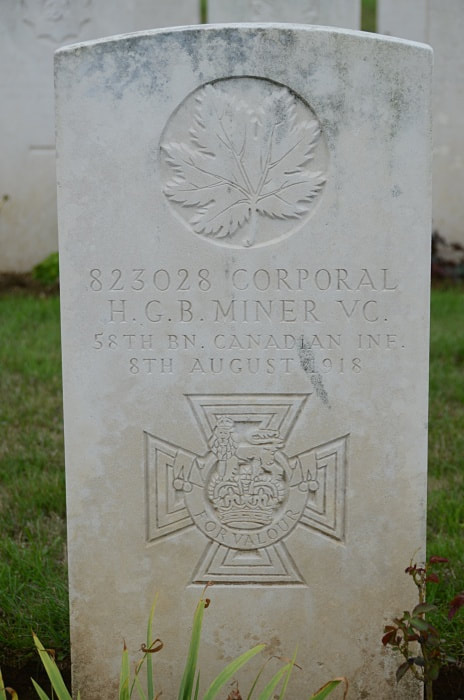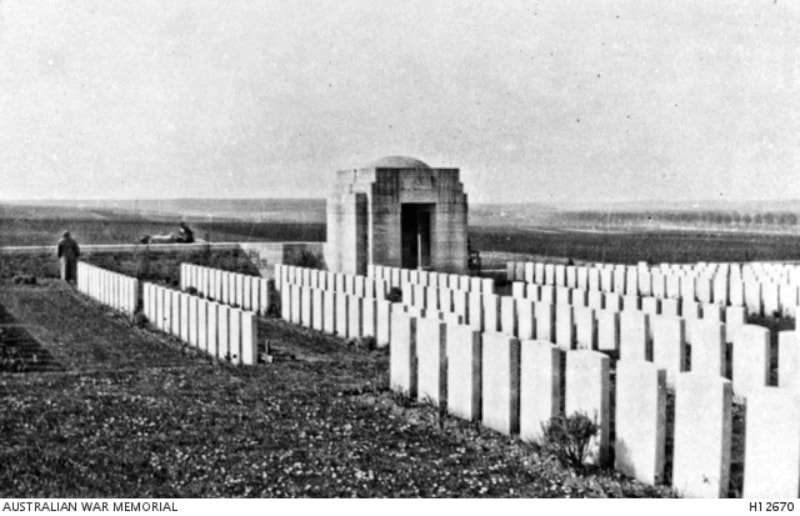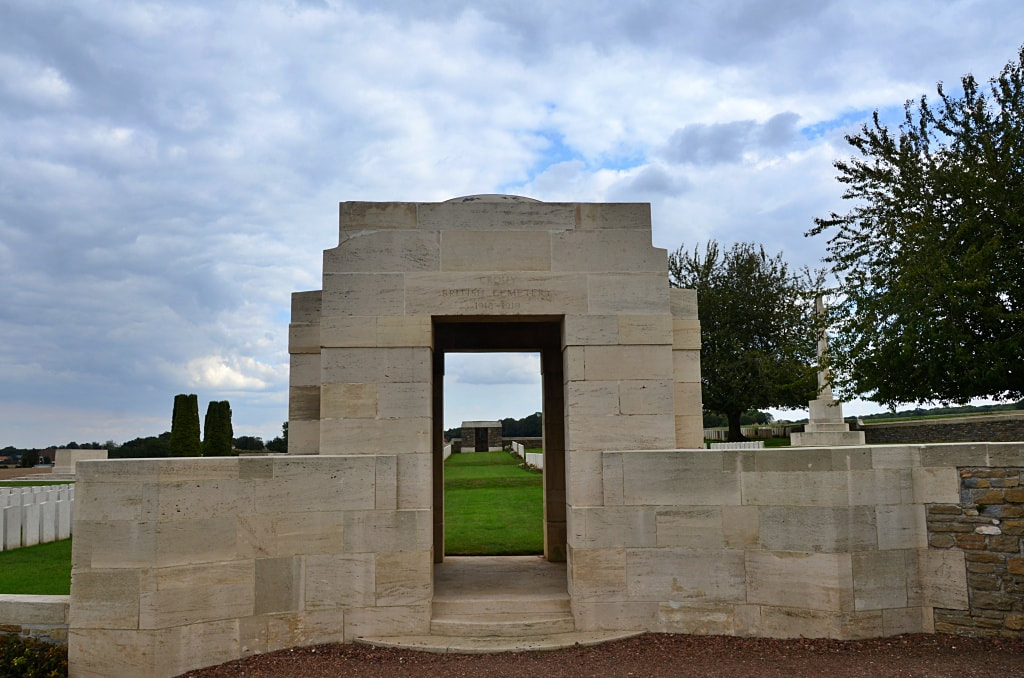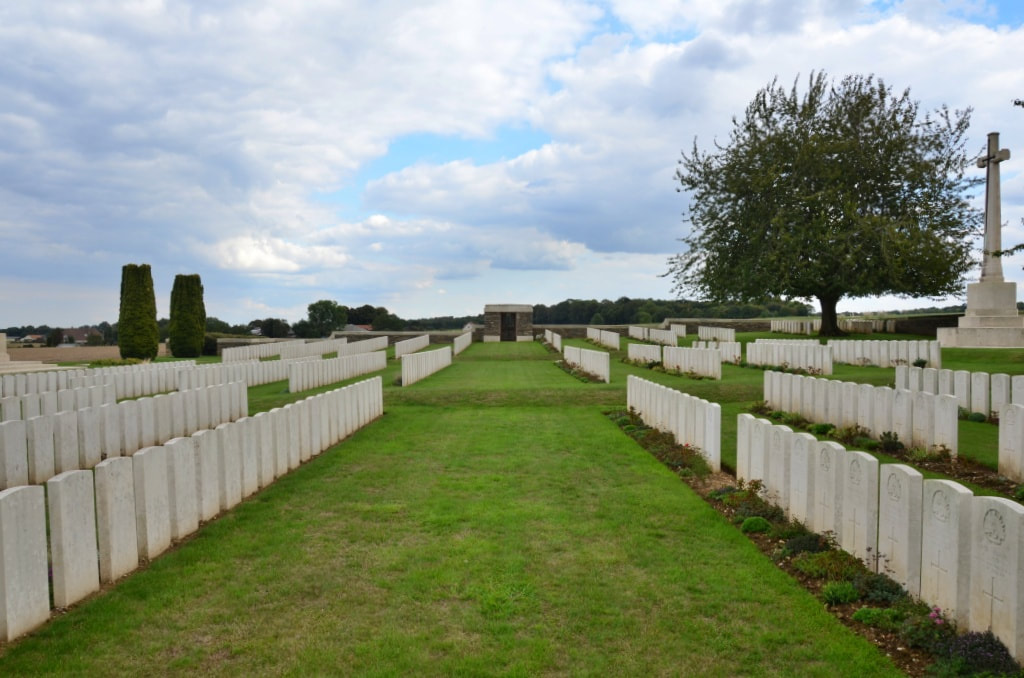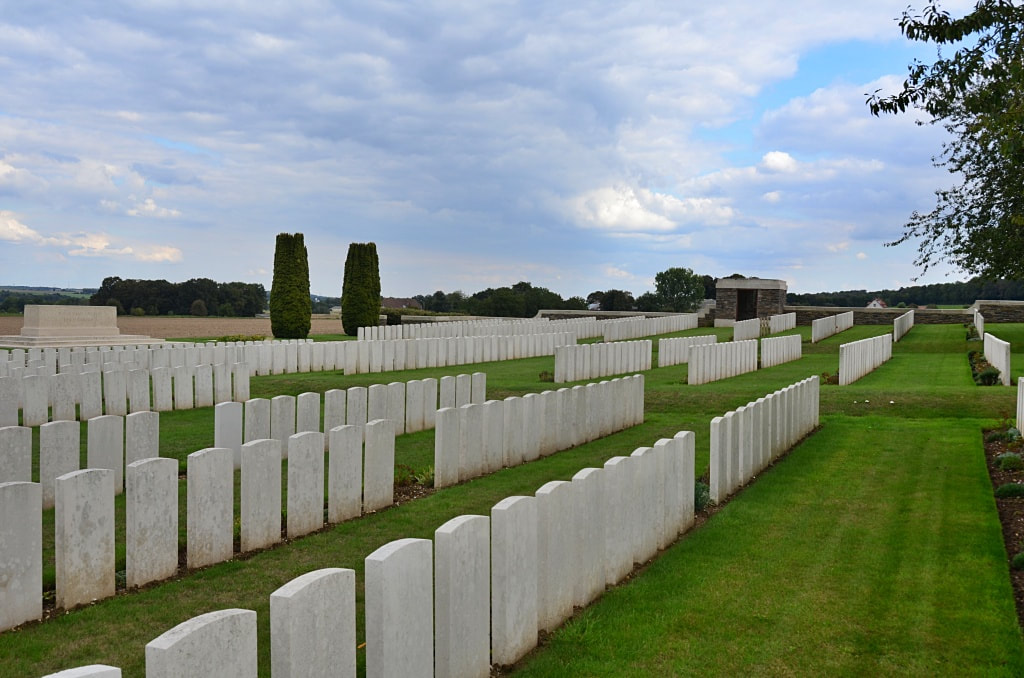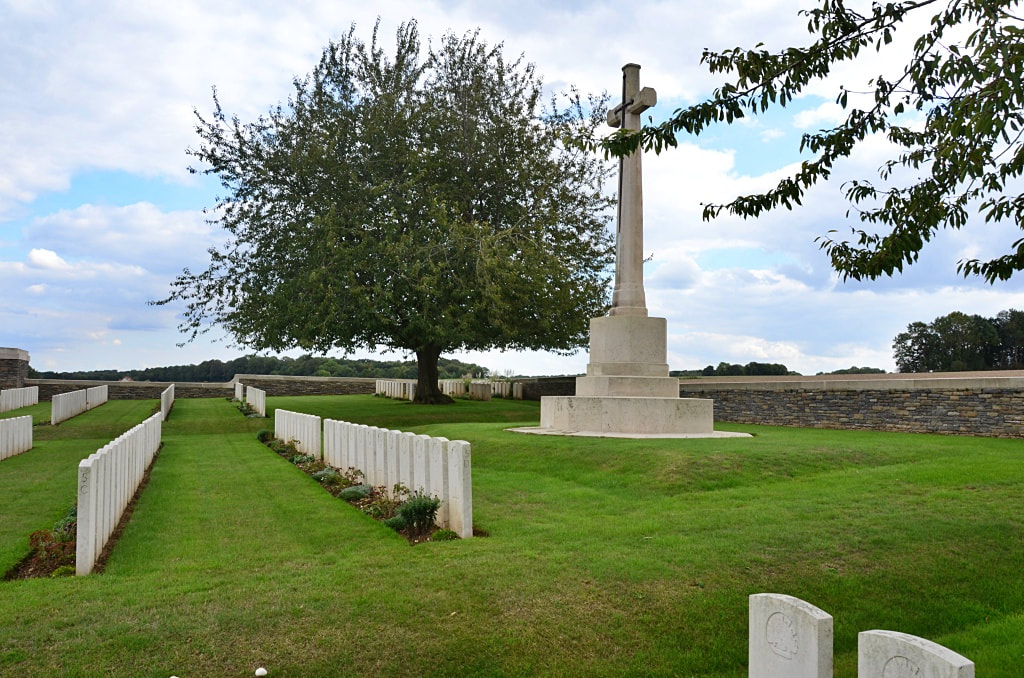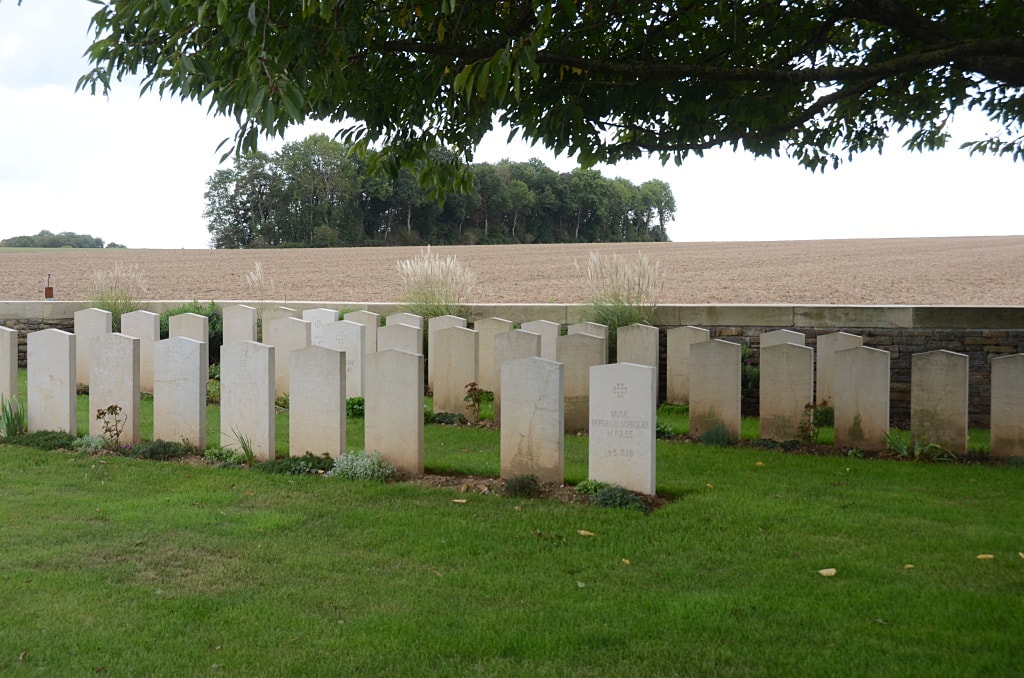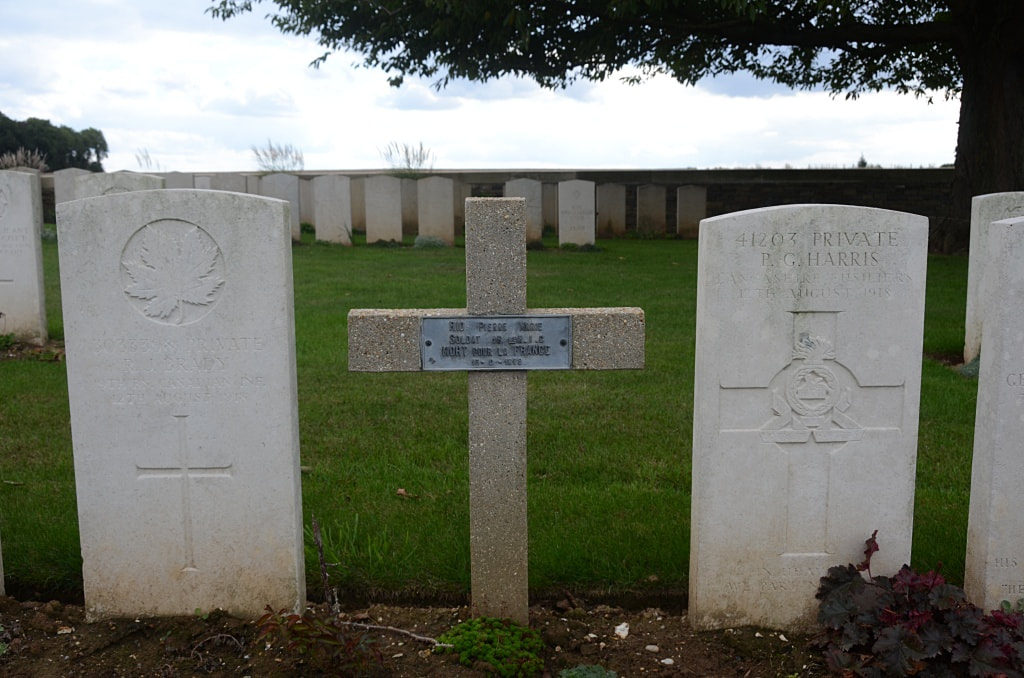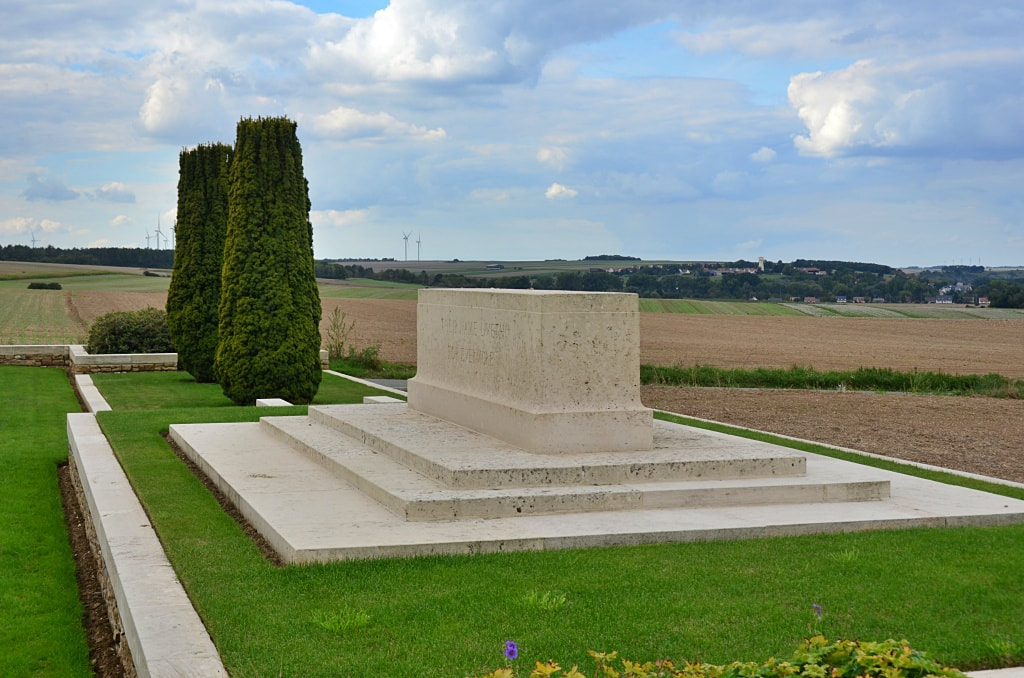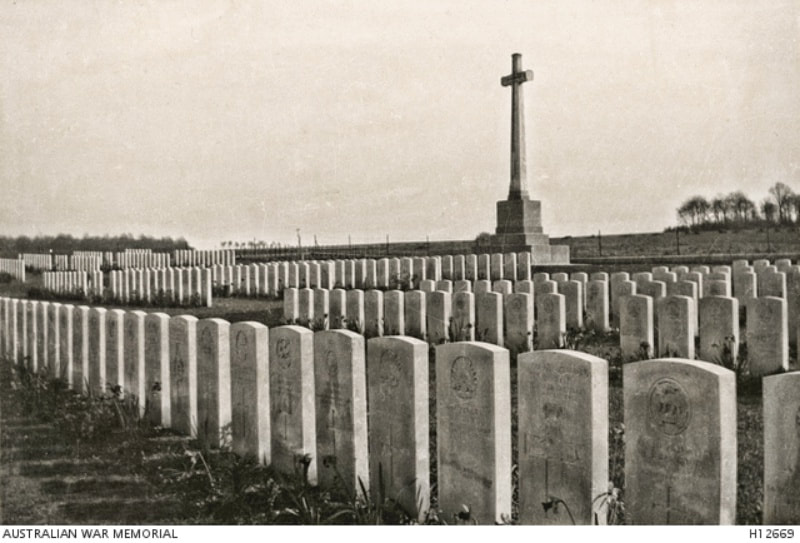CROUY BRITISH CEMETERY
Crouy-sur-Somme
Somme
France
GPS Coordinates: Latitude: 49.96188, Longitude: 2.08345
Location Information
Crouy is a village about 16 kilometres north-west of Amiens on the west side of the River Somme, on the Amiens-Abbeville main road. The British Cemetery is a little south of the village on the west side of the road to Cavillon and there is a Commonwealth War Graves Commission signpost on the main road.
Visiting Information
Wheelchair access is possible with some difficulty.
Historical Information
The cemetery was used between April and August 1918 for burials from the 5th and 47th Casualty Clearing Stations, which had come to the village because of the German advance.
In October 1919, 42 graves were brought to Crouy from the small military cemetery at Riviere, a few kilometres away to the north-west. These burials had been made from the 12th, 53rd and 55th Casualty Clearing Stations at Longpre-les-Corps Saints between May and August 1918. They now occupy rows E and F of plot IV and part of row D, plot VI.
The cemetery now contains 739 Commonwealth burials of the First World War, and a number of French and German war graves.
Total Burials: 783.
Identified Casualties: United Kingdom 280, Australia 276, Canada 179, Germany 37, France 6, India 2. Total 780.
Unknown Casualties: 3.
The cemetery was designed by Sir Reginald Blomfield and William Harrison Cowlishaw
Images in this gallery Geerhard Joos
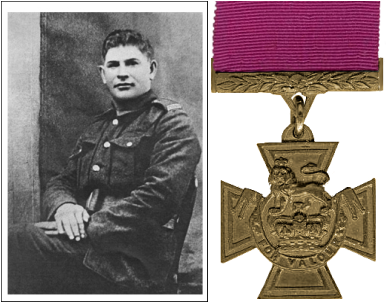
823028 Corporal
Henry (Harry) Garnet Bedford Miner, V. C., Croix de Guerre (France),
58th Bn. Canadian Infantry (Central Ontario Regiment)
8th August 1918, aged 28.
Plot V. B. 2.
Son of John and Sarah Orpha Miner.
Citation:
An extract taken from the London Gazette dated 25th Oct., 1918, records the following : "For most conspicuous bravery and devotion to duty in attack, when despite severe wounds he refused to withdraw. He rushed an enemy machine-gun post single-handed, killed the entire crew and turned the gun on the enemy. Later, with two others, he attacked another enemy machine-gun post, and succeeded in putting the gun out of action. Cpl. Miner then rushed single-handed an enemy bombing post, bayoneting two of the garrison and putting the remainder to flight. He was mortally wounded in the performance of this gallant deed."
Henry (Harry) Garnet Bedford Miner, V. C., Croix de Guerre (France),
58th Bn. Canadian Infantry (Central Ontario Regiment)
8th August 1918, aged 28.
Plot V. B. 2.
Son of John and Sarah Orpha Miner.
Citation:
An extract taken from the London Gazette dated 25th Oct., 1918, records the following : "For most conspicuous bravery and devotion to duty in attack, when despite severe wounds he refused to withdraw. He rushed an enemy machine-gun post single-handed, killed the entire crew and turned the gun on the enemy. Later, with two others, he attacked another enemy machine-gun post, and succeeded in putting the gun out of action. Cpl. Miner then rushed single-handed an enemy bombing post, bayoneting two of the garrison and putting the remainder to flight. He was mortally wounded in the performance of this gallant deed."

3246 Lance Corporal
Michael Ambrose Byrne
13th Bn. Australian Infantry, A. I. F.
5th July 1918, aged 24.
Plot III. D. 2.
Son of Edward Masterson Byrne and Annie Elizabeth Byrne, of "Venita," Cumberland Rd., Auburn, New South Wales. Native of Appin, New South Wales.
A labourer prior to enlisting, he embarked from Sydney aboard HMAT Port Lincoln (A17) on 13 October 1915. He was severely wounded in the chest at Vaire Wood, France on 4 July 1918 and died the next day at the 5th Casualty Clearing Station, France, aged 24.
Michael Ambrose Byrne
13th Bn. Australian Infantry, A. I. F.
5th July 1918, aged 24.
Plot III. D. 2.
Son of Edward Masterson Byrne and Annie Elizabeth Byrne, of "Venita," Cumberland Rd., Auburn, New South Wales. Native of Appin, New South Wales.
A labourer prior to enlisting, he embarked from Sydney aboard HMAT Port Lincoln (A17) on 13 October 1915. He was severely wounded in the chest at Vaire Wood, France on 4 July 1918 and died the next day at the 5th Casualty Clearing Station, France, aged 24.

4115 Private
Donald Cameron
26th Bn. Australian Infantry, A. I. F.
17th July 1918, aged 21.
Plot IV. A. 11.
Son of Alexander and Margaret Cameron, of Reid River, via Townsville, North Queensland.
2182 Private E Arnold described the moment Donald Cameron was mortally wounded:
"He was badly wounded in a daylight raid on Syria trench to the right of Monument Wood, in front of Villers-Bretonneux at midday. Running along too soon after the bombing, he reached the traverse and got a bomb all to himself."
The Matron of the 5th Casualty Clearing Station wrote:
"Private D. Cameron was admitted here on 15th July 1918 and died at 12.40 p.m. on 17th July 1918. He was severely wounded in both legs and arms. He was buried at Crouy on the 18th, Plot 4, row A, grave 11. I wrote full particulars to his mother at the time of his death."
4116 Private (Pte) James Cameron (L) and his brother 4115 (Pte) Donald Cameron with their sisters. The brothers were from Reid River via Townsville, Queensland and both served with the 26th Battalion. James was a 28 year old labourer prior to enlisting on 27 September 1915, Donald a 19 year old draper's assistant when he enlisted the next day. They embarked for overseas with the 10th Reinforcements from Brisbane on 28 March 1916 aboard HMAT Commonwealth (A73) and sailed to England, via Egypt. Following further training in England, they joined the 26th Battalion in France on 28 September 1916. James Cameron was wounded in action at Dernancourt, France but recovered to return to his unit. In December 1916, he spent nine days on temporary attachment to the 7th Trench Mortar Battery. He was killed in action on 3 May 1917 near Bullecourt, France and is commemorated on the Villers-Bretonneux Memorial France with others who have no known grave. Donald Cameron was invalided to England with trench foot in October 1916 and did not return to his battalion until April 1917. He was wounded in action at Broodseinde Ridge, Belgium on 31 October 1917 but returned to his battalion five weeks later. On 14 July 1918, Donald Cameron was wounded in action near Villers-Bretonneux and died from his wounds on 17 July 1918.
Donald Cameron
26th Bn. Australian Infantry, A. I. F.
17th July 1918, aged 21.
Plot IV. A. 11.
Son of Alexander and Margaret Cameron, of Reid River, via Townsville, North Queensland.
2182 Private E Arnold described the moment Donald Cameron was mortally wounded:
"He was badly wounded in a daylight raid on Syria trench to the right of Monument Wood, in front of Villers-Bretonneux at midday. Running along too soon after the bombing, he reached the traverse and got a bomb all to himself."
The Matron of the 5th Casualty Clearing Station wrote:
"Private D. Cameron was admitted here on 15th July 1918 and died at 12.40 p.m. on 17th July 1918. He was severely wounded in both legs and arms. He was buried at Crouy on the 18th, Plot 4, row A, grave 11. I wrote full particulars to his mother at the time of his death."
4116 Private (Pte) James Cameron (L) and his brother 4115 (Pte) Donald Cameron with their sisters. The brothers were from Reid River via Townsville, Queensland and both served with the 26th Battalion. James was a 28 year old labourer prior to enlisting on 27 September 1915, Donald a 19 year old draper's assistant when he enlisted the next day. They embarked for overseas with the 10th Reinforcements from Brisbane on 28 March 1916 aboard HMAT Commonwealth (A73) and sailed to England, via Egypt. Following further training in England, they joined the 26th Battalion in France on 28 September 1916. James Cameron was wounded in action at Dernancourt, France but recovered to return to his unit. In December 1916, he spent nine days on temporary attachment to the 7th Trench Mortar Battery. He was killed in action on 3 May 1917 near Bullecourt, France and is commemorated on the Villers-Bretonneux Memorial France with others who have no known grave. Donald Cameron was invalided to England with trench foot in October 1916 and did not return to his battalion until April 1917. He was wounded in action at Broodseinde Ridge, Belgium on 31 October 1917 but returned to his battalion five weeks later. On 14 July 1918, Donald Cameron was wounded in action near Villers-Bretonneux and died from his wounds on 17 July 1918.

52186 Private
Edward Isherwood Edge
6th Bn. Northamptonshire Regiment
25th April 1918, aged 18.
Plot I. A. 23.
Son of Elizabeth and the late Robert Isherwood Edge, of 32, Tentre St., Burnley.
Edward Isherwood Edge
6th Bn. Northamptonshire Regiment
25th April 1918, aged 18.
Plot I. A. 23.
Son of Elizabeth and the late Robert Isherwood Edge, of 32, Tentre St., Burnley.

1692 Private
Harry Fred Heinrich, M. M.
50th Bn. Australian Infantry, A. I. F.
1st May 1918, aged 29.
Plot I. D. 12.
Son of Gustav Adolph and Pauline Ernstine Heinrich, of Canowie Belt, South Australia. Native of Black Rock, South Australia.
Harry Fred Heinrich is shown wearing an armband with the letters S B indicating that he was a stretcher bearer. A farmer from Canowie Belt, SA prior to enlistment Pte Heinrich embarked with the 2nd Reinforcements from Adelaide on 11 April 1916 aboard HMAT Aeneas. Whilst serving in France he was wounded in action but remained in the field. While serving in Belgium, he was awarded a Military Medal for great courage and energy in attending to the wounded during fighting on Broodseinde Ridge on the night of 18/19 October 1917. After being wounded in action at the battle for Villers-Bretonneux he died from his wounds on 1 May 1918, aged 29.
Harry Fred Heinrich, M. M.
50th Bn. Australian Infantry, A. I. F.
1st May 1918, aged 29.
Plot I. D. 12.
Son of Gustav Adolph and Pauline Ernstine Heinrich, of Canowie Belt, South Australia. Native of Black Rock, South Australia.
Harry Fred Heinrich is shown wearing an armband with the letters S B indicating that he was a stretcher bearer. A farmer from Canowie Belt, SA prior to enlistment Pte Heinrich embarked with the 2nd Reinforcements from Adelaide on 11 April 1916 aboard HMAT Aeneas. Whilst serving in France he was wounded in action but remained in the field. While serving in Belgium, he was awarded a Military Medal for great courage and energy in attending to the wounded during fighting on Broodseinde Ridge on the night of 18/19 October 1917. After being wounded in action at the battle for Villers-Bretonneux he died from his wounds on 1 May 1918, aged 29.

Captain
Albert Mitchell, M. C.
4th Bn. Australian Machine Gun Corps
18th May 1918, aged 26.
Plot II. B. 24.
Son of John and Doretta Mitchell, of Walhalla, Victoria, Australia.
A 22 year old telegraphist prior to enlisting on 17 October 1914, he embarked for overseas as a Private with B Company, 15th Battalion from Melbourne on 22 December 1914 aboard HMAT Ceramic. After joining the battalion in Egypt, he proceeded to Gallipoli where he was promoted and later commissioned as a Second Lieutenant. On being wounded in action, he was evacuated to Egypt and after recovery transferred to the 4th Machine Gun Battalion. Following his arrival in France, he was promoted to Captain, awarded the Military Cross and Mentioned in Despatches. Capt Mitchell was wounded in action on the Somme on 16 May 1918 and died of his wounds two days later.
Albert Mitchell, M. C.
4th Bn. Australian Machine Gun Corps
18th May 1918, aged 26.
Plot II. B. 24.
Son of John and Doretta Mitchell, of Walhalla, Victoria, Australia.
A 22 year old telegraphist prior to enlisting on 17 October 1914, he embarked for overseas as a Private with B Company, 15th Battalion from Melbourne on 22 December 1914 aboard HMAT Ceramic. After joining the battalion in Egypt, he proceeded to Gallipoli where he was promoted and later commissioned as a Second Lieutenant. On being wounded in action, he was evacuated to Egypt and after recovery transferred to the 4th Machine Gun Battalion. Following his arrival in France, he was promoted to Captain, awarded the Military Cross and Mentioned in Despatches. Capt Mitchell was wounded in action on the Somme on 16 May 1918 and died of his wounds two days later.

730803 Private
Charles Ernest Powell
4th Bn. Canadian Infantry
11th August 1918, aged 20.
Plot VI. B. 8.
Son of Charles James and Laura Blanche Powell, of 10, Pearson Avenue, Hyde Park, Headingley, Leeds. Born at Leeds, England.
Charles Ernest Powell
4th Bn. Canadian Infantry
11th August 1918, aged 20.
Plot VI. B. 8.
Son of Charles James and Laura Blanche Powell, of 10, Pearson Avenue, Hyde Park, Headingley, Leeds. Born at Leeds, England.
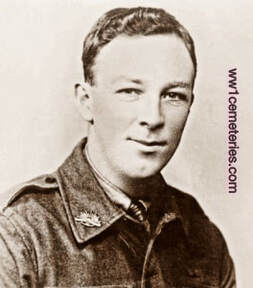
2371 Private
Harold Riddell, D. C. M.
6th Australian Light Trench Mortar Battery
23rd July 1918, aged 28.
Plot IV. B. 7.
Son of William Urquhart Riddell and Marie Riddell, of Fort Fairy, Victoria, Australia. Native of Violet Town, Victoria.
A 25 year old farm labourer prior to enlisting on 13 July 1915, he embarked for overseas with the 5th Reinforcements from Melbourne on 29 September 1915 aboard RMS Osterley. On 14 December 1916 he was awarded the Distinguished Conduct Medal (DCM) for bravery when he heard a bomb fusing in a full magazine and threw it over the parapet where it exploded, saving the rest of the bombs in the magazine from also exploding. He was wounded in action on 22 July 1918 and died the next day.
Harold Riddell was badly injured after a shell exploded in his trench on the morning of 22nd July 1918, he received wounds to his body, arms, legs and head. He died the following day at 5th Casualty Clearing Station. The following day, his brother visited his grave and erected a cross. His parents would eventually have his headstone inscribed with the following words; "Well hast thou fought in freedom's fight dear soldier son, goodnight."
Harold Riddell, D. C. M.
6th Australian Light Trench Mortar Battery
23rd July 1918, aged 28.
Plot IV. B. 7.
Son of William Urquhart Riddell and Marie Riddell, of Fort Fairy, Victoria, Australia. Native of Violet Town, Victoria.
A 25 year old farm labourer prior to enlisting on 13 July 1915, he embarked for overseas with the 5th Reinforcements from Melbourne on 29 September 1915 aboard RMS Osterley. On 14 December 1916 he was awarded the Distinguished Conduct Medal (DCM) for bravery when he heard a bomb fusing in a full magazine and threw it over the parapet where it exploded, saving the rest of the bombs in the magazine from also exploding. He was wounded in action on 22 July 1918 and died the next day.
Harold Riddell was badly injured after a shell exploded in his trench on the morning of 22nd July 1918, he received wounds to his body, arms, legs and head. He died the following day at 5th Casualty Clearing Station. The following day, his brother visited his grave and erected a cross. His parents would eventually have his headstone inscribed with the following words; "Well hast thou fought in freedom's fight dear soldier son, goodnight."
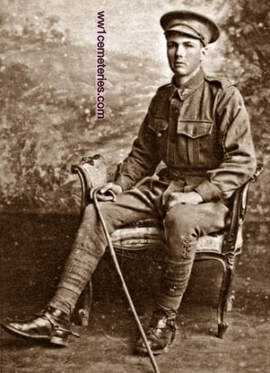
1258 Driver
Frederick Robert Roy
42nd Bty. 11th Bde. Australian Field Artillery
Died Between 05/07/1918 and 09/07/1918
Plot III. E. 20.
Son of Mrs C. M. Roy, Galah Street, Longreach, Queensland.
Dvr Roy enlisted at Longreach, Qld on 29 August 1915, and embarked from Adelaide, SA, aboard HMAT Benalla on 27 October 1915 he was found to have drowned between 5th and 9th July 1918.
Frederick Robert Roy
42nd Bty. 11th Bde. Australian Field Artillery
Died Between 05/07/1918 and 09/07/1918
Plot III. E. 20.
Son of Mrs C. M. Roy, Galah Street, Longreach, Queensland.
Dvr Roy enlisted at Longreach, Qld on 29 August 1915, and embarked from Adelaide, SA, aboard HMAT Benalla on 27 October 1915 he was found to have drowned between 5th and 9th July 1918.
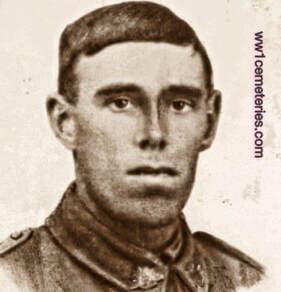
254 Private
Archibald Scott
56th Bn. Australian Infantry, A. I. F.
21st May 1918
Plot II. C. 11.
Husband of Edith Scott.
Archie Scott was badly wounded on 20th May 1918 by a long range shell whilst serving with the Military Police at Daours. He was admitted to 47th Casualty Clearing Station with wounds to his legs, right arm and back, he underwent an operation but never regained consciousness and died on 21st May 1918. He was buried at Crouy the following day.
His wife would add the following to his headstone "Rest in Peace, his loving wife & children. Edith Scott."
Archibald Scott
56th Bn. Australian Infantry, A. I. F.
21st May 1918
Plot II. C. 11.
Husband of Edith Scott.
Archie Scott was badly wounded on 20th May 1918 by a long range shell whilst serving with the Military Police at Daours. He was admitted to 47th Casualty Clearing Station with wounds to his legs, right arm and back, he underwent an operation but never regained consciousness and died on 21st May 1918. He was buried at Crouy the following day.
His wife would add the following to his headstone "Rest in Peace, his loving wife & children. Edith Scott."

6883 Private
George Selway
48th Bn. Australian Infantry, A. I. F.
25th June 1918, aged 21.
Plot III. C. 1.
Only son of George Alfred and Mary Alice Selway, of Esplanade, Glenelg, South Australia. Native of Adelaide, South Australia.
A law clerk prior to enlistment, Pte Selway was initially posted to the 27th Battalion, before being transferred to the 48th Battalion in April 1918 when the latter unit required reinforcements after suffering heavy casualties. Pte Selway was involved in fighting near Sailly-le-Sec, east of Amiens, when he was wounded on 23 June 1918. He was evacuated to the 5th Casualty Clearing Station, however died of his wounds two days later, aged 21.
George Selway
48th Bn. Australian Infantry, A. I. F.
25th June 1918, aged 21.
Plot III. C. 1.
Only son of George Alfred and Mary Alice Selway, of Esplanade, Glenelg, South Australia. Native of Adelaide, South Australia.
A law clerk prior to enlistment, Pte Selway was initially posted to the 27th Battalion, before being transferred to the 48th Battalion in April 1918 when the latter unit required reinforcements after suffering heavy casualties. Pte Selway was involved in fighting near Sailly-le-Sec, east of Amiens, when he was wounded on 23 June 1918. He was evacuated to the 5th Casualty Clearing Station, however died of his wounds two days later, aged 21.

2143A Private
John Donald Woodfield
24th Bn. Australian Infantry, A. I. F.
7th July 1918, aged 34.
Plot III. E. 4.
Son of John Donald and Elizabeth M. Woodfield, of Yartla, Coms Avenue, South Yarra, Victoria, Australia. Native of Goulburn, New South Wales.
A 32 year old grazier prior to enlisting on 23 May 1916, he embarked for overseas with the 15th Reinforcements of the 13th Australian Light Horse Regiment from Melbourne on 6 December 1916 aboard HMAT Orsova. On arrival in England, he transferred to the 24th Battalion and served with them in France where he was wounded in action at the Battle of Hamel. He died from his wounds on 7th July 1918.
Jack Woodfield was part of a fatigue party when he was hit by a shell near Villers-Bretonneux, he was carried to the Dressing Station by German prisoners and admitted to 47th Casualty Clearing Station on 4th July 1918 with a 'Shell wound involving a fractured thigh,' no operation was possible and Jack died on the 7th July 1918.
John Donald Woodfield
24th Bn. Australian Infantry, A. I. F.
7th July 1918, aged 34.
Plot III. E. 4.
Son of John Donald and Elizabeth M. Woodfield, of Yartla, Coms Avenue, South Yarra, Victoria, Australia. Native of Goulburn, New South Wales.
A 32 year old grazier prior to enlisting on 23 May 1916, he embarked for overseas with the 15th Reinforcements of the 13th Australian Light Horse Regiment from Melbourne on 6 December 1916 aboard HMAT Orsova. On arrival in England, he transferred to the 24th Battalion and served with them in France where he was wounded in action at the Battle of Hamel. He died from his wounds on 7th July 1918.
Jack Woodfield was part of a fatigue party when he was hit by a shell near Villers-Bretonneux, he was carried to the Dressing Station by German prisoners and admitted to 47th Casualty Clearing Station on 4th July 1918 with a 'Shell wound involving a fractured thigh,' no operation was possible and Jack died on the 7th July 1918.
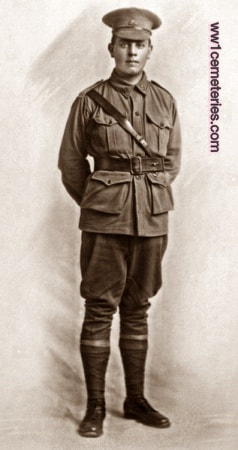
5129 Company Sergeant Major
Andrew Gordon Woodyard
29th Bn. Australian Infantry, A. I. F.
7th August 1918, aged 25.
Plot IV. D. 23.
Son of John Thomas and Christina Annie Woodyard; husband of Irene W. A. Woodyard, of Walton, Ashgrove, Brisbane, Queensland. Native of Melbourne, Victoria.
A 26 year old professional soldier prior to enlisting in the AIF on 26 November 1917, he embarked for overseas with the 14th Reinforcements of the 29th Battalion from Melbourne on 22 December 1917 aboard HMAT Ulysses. Following further training in England, he joined the 29th Battalion in France on 6 June 1918. He was wounded in action near Amiens, France and subsequently died from his wounds.
Andrew Woodyard died of wounds received when a piece of shell struck him in the chest while he was sat outside his dugout. He was taken to the Dressing Station but succumbed to his wound.
His wife would add the following inscription to his headstone; "Husband of Win and father of Betty. For love is as strong as death."
Andrew Gordon Woodyard
29th Bn. Australian Infantry, A. I. F.
7th August 1918, aged 25.
Plot IV. D. 23.
Son of John Thomas and Christina Annie Woodyard; husband of Irene W. A. Woodyard, of Walton, Ashgrove, Brisbane, Queensland. Native of Melbourne, Victoria.
A 26 year old professional soldier prior to enlisting in the AIF on 26 November 1917, he embarked for overseas with the 14th Reinforcements of the 29th Battalion from Melbourne on 22 December 1917 aboard HMAT Ulysses. Following further training in England, he joined the 29th Battalion in France on 6 June 1918. He was wounded in action near Amiens, France and subsequently died from his wounds.
Andrew Woodyard died of wounds received when a piece of shell struck him in the chest while he was sat outside his dugout. He was taken to the Dressing Station but succumbed to his wound.
His wife would add the following inscription to his headstone; "Husband of Win and father of Betty. For love is as strong as death."
Images in this gallery © Johan Pauwels
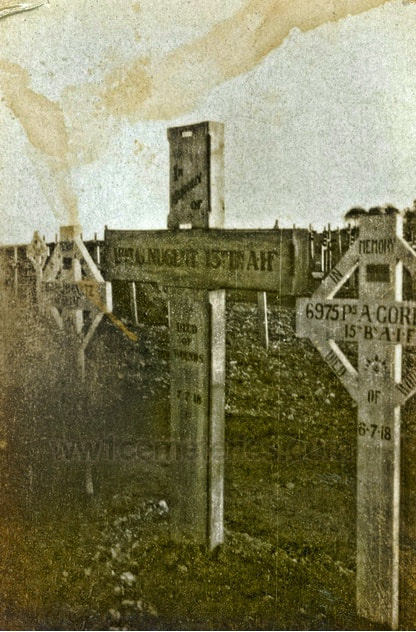
Grave marker of Lieutenant (Lt) George Nugent, 13th Battalion. Nugent, of Queanbeyan, Nsw, was a teacher prior to enlistment as a second Lieutenant on 16 February 1916. He had served 14 years in the Citizens' Military Forces, and spent one and a half years in the South African War where he won the Queen's Medal. He embarked from Sydney aboard HMAT Euripides (A14) on 9 September 1916 with the 20th Reinforcements. He served on the Western Front and was promoted to Lieutenant (Lt) on 18 April 1917. Lt Nugent died of wounds on 7 July 1918, aged 40. He is buried in Plot III. D. 26.


